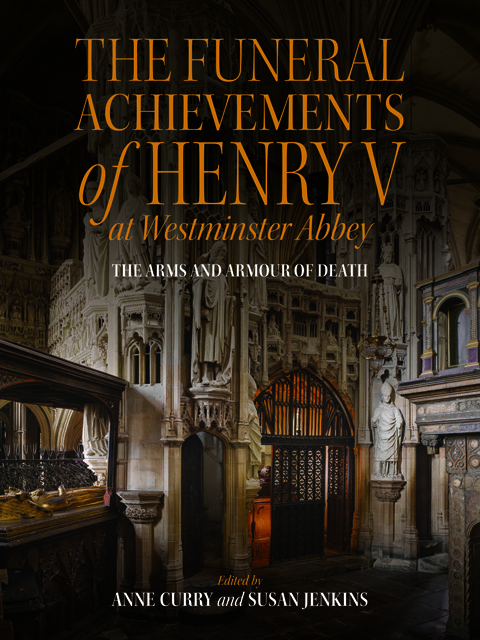Book contents
- Frontmatter
- Dedication
- Contents
- List of Illustrations
- List of Contributors
- Foreword
- Preface
- Acknowledgements
- List of Abbreviations
- 1 Introduction: Henry V and Westminster Abbey – Life, Death and Afterlife
- 2 Henry V’s Funeral Achievements in the Context of Westminster Abbey : ‘Trophies of this Warlike Prince’
- 3 The Funeral of Henry V
- 4 Henry V’s Chapel
- 5 The Funerary Helm of King Henry V : A Helm for the Joust of Peace, c. 1380–1420
- 6 A Saddle from the Funeral of Henry V
- 7 The Shield from the Funeral Achievements of Henry V
- 8 ‘Our bruisèd arms hung up for monuments’. The Sword of Henry V?
- 9 Conservation of the Funeral Achievements
- 10 Scientific Analysis: Micro-Invasive Techniques
- 11 Scientific Analysis: Non-Invasive Techniques
- Appendix: The Will of Henry V, 1421
- Index of People and Places
- Royal Armouries Research Series
5 - The Funerary Helm of King Henry V : A Helm for the Joust of Peace, c. 1380–1420
Published online by Cambridge University Press: 11 January 2023
- Frontmatter
- Dedication
- Contents
- List of Illustrations
- List of Contributors
- Foreword
- Preface
- Acknowledgements
- List of Abbreviations
- 1 Introduction: Henry V and Westminster Abbey – Life, Death and Afterlife
- 2 Henry V’s Funeral Achievements in the Context of Westminster Abbey : ‘Trophies of this Warlike Prince’
- 3 The Funeral of Henry V
- 4 Henry V’s Chapel
- 5 The Funerary Helm of King Henry V : A Helm for the Joust of Peace, c. 1380–1420
- 6 A Saddle from the Funeral of Henry V
- 7 The Shield from the Funeral Achievements of Henry V
- 8 ‘Our bruisèd arms hung up for monuments’. The Sword of Henry V?
- 9 Conservation of the Funeral Achievements
- 10 Scientific Analysis: Micro-Invasive Techniques
- 11 Scientific Analysis: Non-Invasive Techniques
- Appendix: The Will of Henry V, 1421
- Index of People and Places
- Royal Armouries Research Series
Summary
Four mounted knights rode in the funeral procession of King Henry V. Two of them, as an account of the funeral relates, carried shields, one emblazoned with the royal arms of England and the other of France. Of the second pair, one bore ‘the helm’ and the other carried ‘the crest of the same’. The following March, the royal wardrobe paid Thomas Daunt 33s 4d for ‘the painting of a crest and of a helm for the King’. These are the earliest references to the funerary helm of Henry V, which remains in Westminster Abbey (Fig. 5.1). At some point, it was set up along with the crest, a sword and a shield as Henry’s funerary achievements, following the example of his great uncle Edward, the Black Prince (d. 1376) whose monument and achievements are preserved in Canterbury Cathedral. The crest and the sword are sadly now lost, while the shield is probably that remaining in the Abbey, as discussed elsewhere in this volume.
Construction, Design and Function
The helm is composed of five primary plates:
1. Rear plate, making up the whole back of the helm and extending around to the sides of the head. A strongly built strap-loop is riveted centrally to the base of the rear plate, for attachment of the helm to the back of the wearer’s body armour. A later mounting hook, almost certainly fitted at the time of the helm’s conversion for funerary use, has been riveted to the rear plate over the nape of the neck.
2. Brow plate, forming the whole front of the helm above the eyes.
3. Crown plate, a small piece filling a gap between the rear plate and the brow plate at the top of the head.
4. Face plate, covering the front and sides of the face below the eyes, wrapping around behind the position of the wearer’s ears to join with the rear-plate. The face plate is also joined to the lower edges of the brow plate just behind the area of the wearer’s temples, with the helm sight formed by a gap between the lower edge of the brow plate and the upper edge of the face plate, at the front.
- Type
- Chapter
- Information
- The Funeral Achievements of Henry V at Westminster AbbeyThe Arms and Armour of Death, pp. 92 - 127Publisher: Boydell & BrewerPrint publication year: 2022



